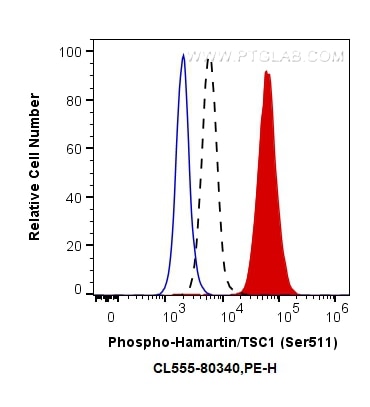Tested Applications
| Positive FC (Intra) detected in | Calyculin A treated HeLa cells |
Recommended dilution
| Application | Dilution |
|---|---|
| Flow Cytometry (FC) (INTRA) | FC (INTRA) : 0.50 ug per 10^6 cells in a 100 µl suspension |
| It is recommended that this reagent should be titrated in each testing system to obtain optimal results. | |
| Sample-dependent, Check data in validation data gallery. | |
Product Information
CL555-80340 targets Phospho-Hamartin/TSC1 (Ser511) in FC (Intra) applications and shows reactivity with human, mouse samples.
| Tested Reactivity | human, mouse |
| Host / Isotype | Rabbit / IgG |
| Class | Recombinant |
| Type | Antibody |
| Immunogen |
Peptide Predict reactive species |
| Full Name | tuberous sclerosis 1 |
| Calculated Molecular Weight | 130 kDa |
| Observed Molecular Weight | 150 kDa |
| GenBank Accession Number | NM_000368 |
| Gene Symbol | Hamartin/TSC1 |
| Gene ID (NCBI) | 7248 |
| RRID | AB_2934694 |
| Conjugate | CoraLite®555 Fluorescent Dye |
| Excitation/Emission Maxima Wavelengths | 557 nm / 570 nm |
| Form | Liquid |
| Purification Method | Protein A purification |
| UNIPROT ID | Q92574 |
| Storage Buffer | PBS with 50% glycerol, 0.05% Proclin300, 0.5% BSA, pH 7.3. |
| Storage Conditions | Store at -20°C. Avoid exposure to light. Stable for one year after shipment. Aliquoting is unnecessary for -20oC storage. |
Background Information
TSC1, also named as Hamartin, is a tumor suppressor gene syndrome whose manifestations can include seizures, mental retardation, autism, and tumors in the brain, retina, kidney, heart, and skin. The tuberous sclerosis 1 (TSC1)/TSC2 tumor suppressor complex serves as a repressor of the mTOR pathway, and disruption of TSC1/TSC2 complex function may contribute to tumorigenesis. TSC1 is phosphorylated by IKKb at Ser487 and Ser511 in vitro and in vivo, and phosphorylation at these sites enhances dissociation of the TSC1/TSC2 complex, which in turn induces mTOR activation. (PMID: 17693255). TSC1 is also threonine-phosphorylated at three sites (Thr417, Ser584, and Thr1047) in a reaction catalyzed by cyclin-dependent kinase 1 (CDK1) (PMID: 14551205).




